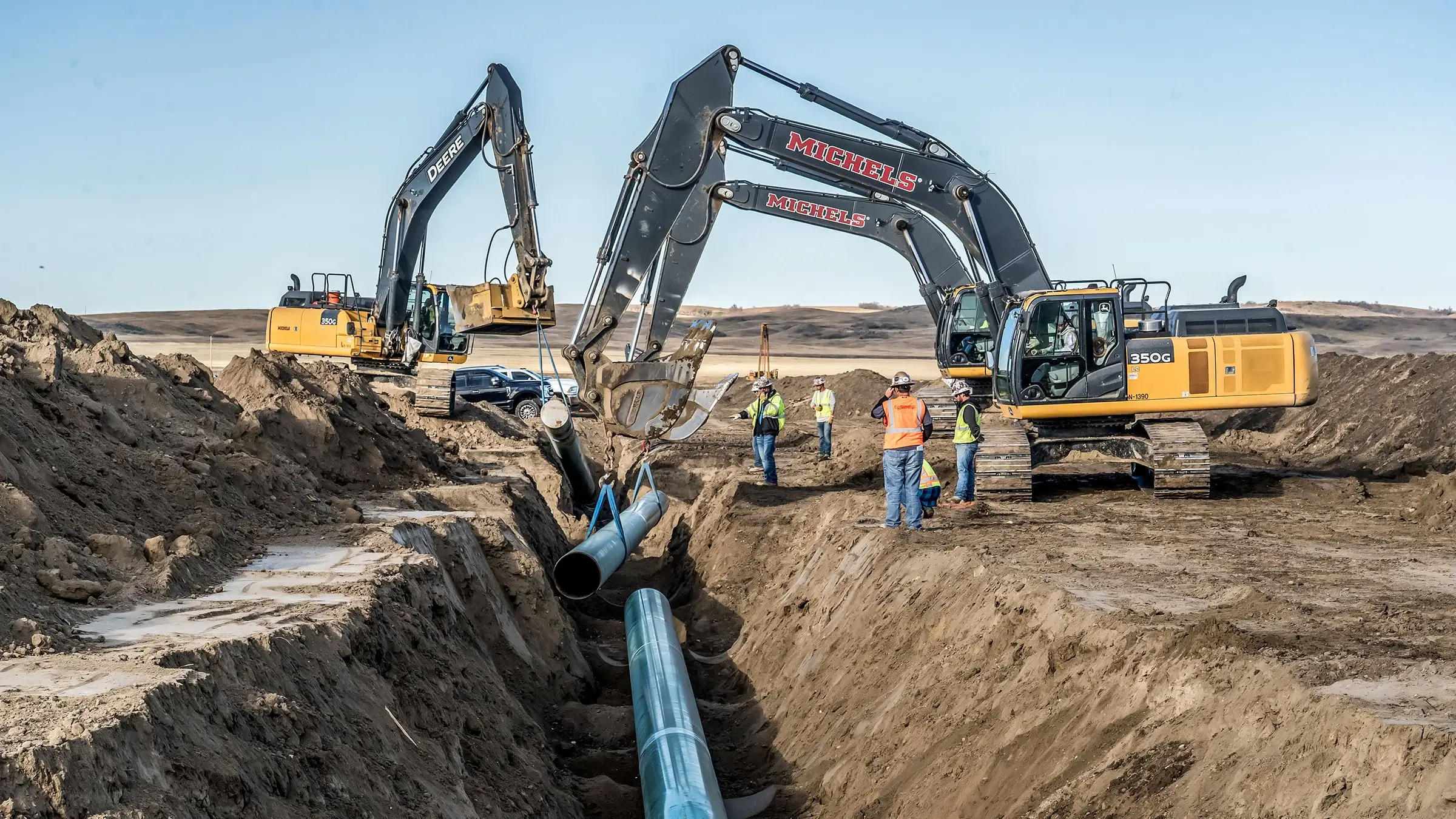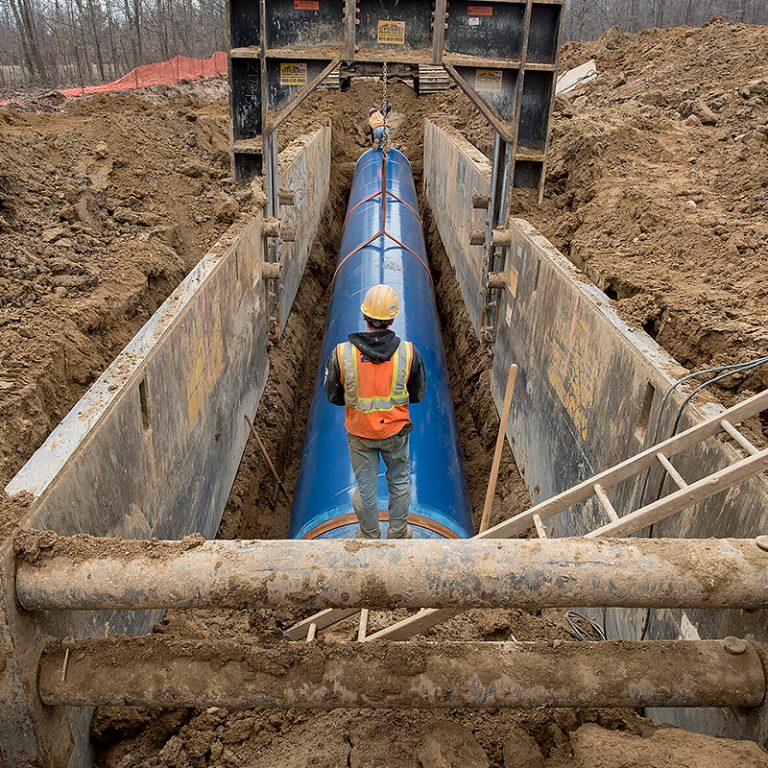Complete Guide to Creek Pipe roustabout Work in Oilfield Operations
Wiki Article
The Relevance of Pipeline Construction: Checking Out the Solutions Provided in the Market
Pipeline construction is a vital part of modern infrastructure. It assists in the transport of vital resources like oil, gas, and water. The industry incorporates various services, consisting of preparation, site prep work, and installment. Each phase calls for accuracy and adherence to safety requirements. As areas depend on these systems for their resources, understanding the complexities of pipe construction reveals its significance and prospective difficulties. What factors affect the success of these jobs?Overview of Pipeline Construction Providers
Pipeline construction services incorporate a series of specific activities created to help with the installment of pipes for carrying various compounds, consisting of oil, gas, and water. These services generally consist of site prep work, excavation, setup of pipeline segments, and backfilling. Competent labor and advanced devices are basic for assuring each phase is implemented with accuracy and safety.Safety protocols are paramount, as these jobs typically entail dealing with unsafe materials and in tough settings. Quality control steps ascertain that the pipes meet market standards and regulations. Additionally, the solutions might include trenchless technology, which minimizes surface area disruption.Environmental factors to consider play a substantial duty in pipeline construction, calling for assessments and reductions to secure bordering ecosystems. In general, pipeline construction services are vital for establishing the framework necessary for power and water circulation, sustaining both financial growth and social requirements.Planning and Design in Pipeline Projects
Efficient planning and style are important elements of effective pipeline tasks, ensuring that all facets are thoroughly addressed before construction starts. This phase entails detailed feasibility researches that assess the technological, economic, and environmental factors affecting the job. Designers and developers team up to create thorough plans that describe the pipeline route, products, and construction approaches, straightening with regulative needs and sector standards.Advanced software program and modeling methods are often employed to imitate different circumstances, optimizing the style for performance and security. Environmental influence evaluations are conducted to reduce potential injury to environments and neighborhoods, reflecting a commitment to sustainable methods. In addition, stakeholder engagement is important, promoting interaction and dealing with concerns from influenced celebrations. Eventually, efficient planning and style established the foundation for a pipe job, lessening threats and guaranteeing a streamlined construction procedure, ultimately adding to the overall success of the operation.Site Preparation and Excavation
Detailed website preparation and excavation are crucial action in the pipeline construction process. This stage includes an in-depth evaluation of the land where the pipe will certainly be mounted. Project groups perform studies to identify dirt kinds, topography, and existing energy lines to guarantee a secure and effective excavation. Appropriate site preparation decreases ecological effect and promotes smoother construction operations.Excavation complies with, where hefty machinery is utilized to remove dirt and rock, producing a trench that meets the defined deepness and width for the pipe. This procedure should stick to security guidelines and environmental standards to avoid damages to surrounding ecosystems.Additionally, erosion control procedures are carried out to stabilize the site during and after excavation. Efficient website prep work and excavation add significantly to the general success of pipeline tasks, laying a strong foundation for the subsequent stages of construction.Pipeline Installation Techniques
Pipeline installation methods are necessary for the effective application of facilities jobs. Two popular methods include trenchless innovation, which lessens surface area interruption, and the open-cut excavation procedure, understood for its simple strategy. Each method supplies unique benefits and considerations relying on job demands and environmental factors.Trenchless Modern Technology Approaches
While traditional methods of pipe setup commonly involve extensive excavation, trenchless technology techniques supply an extra reliable and eco-friendly choice. These ingenious strategies, such as horizontal directional exploration and pipe bursting, lessen surface interruption by enabling the installment of pipelines without extensive digging. This not only reduces the ecological effect yet likewise significantly minimizes labor and repair prices. Trenchless approaches facilitate the setup of pipes in city areas where standard excavation would certainly be impractical or harmful to existing facilities. In addition, these techniques can fit different dirt kinds and conditions, making them versatile services for pipe construction. Inevitably, trenchless modern technology represents a significant innovation in the pipeline market, advertising sustainability and operational efficiency.
Open-Cut Excavation Refine
Open-cut excavation remains an essential method in pipe installment, identified by the direct excavation of a trench to lay pipes. This technique entails getting rid of dirt and other materials to produce a trench of enough deepness and size, enabling the placement of pipes at the called for quality. Open-cut excavation is commonly favored for its cost-effectiveness and simpleness, particularly in locations with secure dirt conditions. It can interrupt surface activities and requires careful planning to manage traffic and ecological effects. Precaution need to be carried out to secure workers and neighboring infrastructure throughout the excavation process. On the whole, while open-cut excavation might not appropriate for all terrains, it continues to be a commonly utilized strategy in pipeline construction.Examining and Quality Control
Testing and quality control are essential parts in pipeline construction, guaranteeing that installments fulfill well established safety criteria and efficiency requirements. Numerous examination methods and approaches are utilized to assess worldly quality and adherence to governing conformity. This methodical approach aids identify possible problems prior to they escalate, guarding the integrity of the pipe system.
Inspection Techniques and Techniques
Evaluation techniques and approaches are vital components in guaranteeing the honesty and security of pipeline construction. Numerous strategies, consisting of visual evaluations, ultrasonic testing, and radiographic assessments, are employed to identify flaws and verify high quality. Aesthetic examinations enable the recognition of surface abnormalities, while ultrasonic his response testing makes use of sound waves to analyze wall thickness and situate defects internally. Radiographic evaluations involve X-rays or gamma rays to create photos of the pipe's structure, disclosing concealed issues. Furthermore, stress testing is conducted to assess the pipeline's integrity under functional problems. These techniques jointly add to a complete understanding of the pipe's problem, allowing prompt upkeep choices and making certain conformity with sector criteria. Reliable inspection is critical for preventing failings and advertising lasting operational safety.Security Specifications Conformity
Making sure compliance with safety requirements is extremely important in pipe construction, as it directly impacts the task's total high quality and dependability. Sticking to well-known guidelines and standards assurances that construction techniques alleviate threats connected with pipeline setup and operation. Creek Pipe roustabout. Extensive screening protocols, including non-destructive screening and pressure assessments, are essential in validating that pipes can stand up to the operational stresses they will certainly experience. Quality control steps are also important, as they develop a structure for consistent monitoring and examination throughout the construction procedure. By prioritizing safety standards conformity, companies not only protect workers and the setting but likewise enhance the honesty of the pipeline, eventually resulting helpful resources in long-term functional success and public count on in the infrastructureMaterial Quality Evaluation
Material top quality assessment plays a substantial role in the general integrity of pipe construction. This procedure involves extensive screening and quality control actions to ensure that products satisfy industry criteria and specifications. Different examinations, including tensile toughness, rust resistance, and weld honesty evaluations, are performed to identify any type of possible weak points. A complete analysis not just guarantees the performance of the pipe yet also enhances safety and security and sturdiness over its life-span. Additionally, carrying out top quality control protocols assists reduce threats related to material failings, which can bring about pricey fixings and ecological dangers. By prioritizing material quality evaluation, companies can guarantee conformity with governing needs while promoting self-confidence among stakeholders in the reliability of their pipe systems.Maintenance and Repair Work Solutions
Repair and maintenance solutions play an essential role in the longevity and efficiency of pipeline systems. These solutions incorporate routine evaluations, fixing, and corrective activities to deal with deterioration, leakages, and various other problems that may occur gradually. Competent specialists make use of advanced modern technologies such as ultrasonic screening and smart pigging to check pipe integrity, guaranteeing that any kind of potential troubles are recognized early.Additionally, upkeep programs usually consist of set up preventative actions created to boost system reliability and lower the chance of unforeseen failures. Repair solutions may include the replacement of broken sections, securing leaks, or using trenchless innovation for minimal interruption.find this
Environmental Conformity and Precaution
Pipeline systems not only call for ongoing upkeep and repair to work successfully however also should follow rigid environmental conformity and precaution. These guidelines are necessary for reducing eco-friendly effect and ensuring public security. Companies in the pipeline construction market implement complete environmental evaluations prior to job initiation, recognizing potential dangers to wild animals and ecosystems.Furthermore, adherence to safety protocols secures employees and surrounding neighborhoods. This consists of normal training on emergency situation response and spill prevention techniques.To preserve compliance, markets make use of keeping track of innovations to identify leaks and other anomalies in real-time. Ecological administration strategies are usually developed to outline steps for attending to unpredicted issues during construction.Ultimately, stringent adherence to environmental conformity and safety and security procedures not only fulfills legal responsibilities yet additionally cultivates lasting techniques within the industry, advertising a balance in between infrastructure growth and environmental stewardship.Often Asked Concerns
What Occupation Opportunities Are Readily Available in Pipeline Construction?
Career opportunities in pipeline construction include functions such as project managers, engineers, welders, and safety examiners. These settings need varied abilities, offering paths for growth in an essential industry of facilities development and power distribution.

How Do Pipeline Projects Impact Local Communities?
Pipeline tasks substantially influence regional areas by influencing financial growth, offering task opportunities, and boosting facilities. They might also elevate concerns concerning environmental results, land use, and possible interruptions to area cohesion and natural ecosystems.
What Technology Is Made Use Of in Modern Pipeline Construction?
Modern pipeline construction makes use of advanced innovations such as GIS for mapping, drones for airborne surveys, and automated welding systems to improve efficiency, security, and accuracy, ultimately promoting the effective transport of resources across different surfaces. Creek Pipe Texas oilfield.Just How Are Pipeline Construction Costs Approximated?
Pipeline construction prices are estimated with detailed evaluations of products, labor, tools, and regulatory demands. Aspects like surface, task dimension, and environmental considerations likewise substantially influence the overall budget plan and monetary preparation for construction.What Are the Most Significant Obstacles in Pipeline Construction Projects?
The largest obstacles in pipe construction tasks consist of governing conformity, ecological problems, logistical problems, safeguarding financing, and managing labor shortages. Each variable can substantially impact timelines and budgets, making complex the total implementation of the task.Report this wiki page